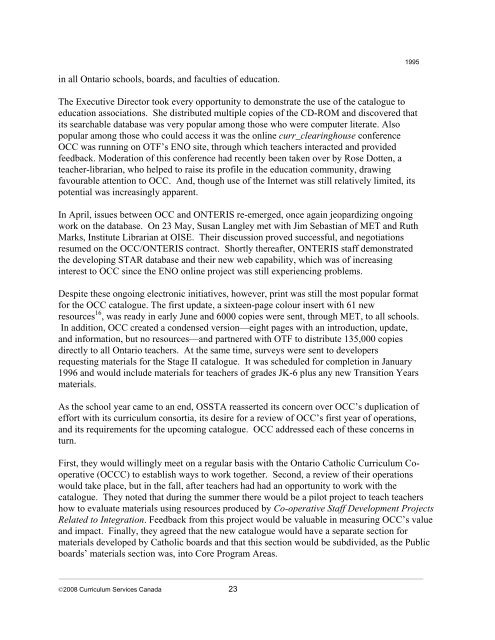a history of curriculum services canada
a history of curriculum services canada
a history of curriculum services canada
Create successful ePaper yourself
Turn your PDF publications into a flip-book with our unique Google optimized e-Paper software.
1995<br />
in all Ontario schools, boards, and faculties <strong>of</strong> education.<br />
The Executive Director took every opportunity to demonstrate the use <strong>of</strong> the catalogue to<br />
education associations. She distributed multiple copies <strong>of</strong> the CD-ROM and discovered that<br />
its searchable database was very popular among those who were computer literate. Also<br />
popular among those who could access it was the online curr_clearinghouse conference<br />
OCC was running on OTF’s ENO site, through which teachers interacted and provided<br />
feedback. Moderation <strong>of</strong> this conference had recently been taken over by Rose Dotten, a<br />
teacher-librarian, who helped to raise its pr<strong>of</strong>ile in the education community, drawing<br />
favourable attention to OCC. And, though use <strong>of</strong> the Internet was still relatively limited, its<br />
potential was increasingly apparent.<br />
In April, issues between OCC and ONTERIS re-emerged, once again jeopardizing ongoing<br />
work on the database. On 23 May, Susan Langley met with Jim Sebastian <strong>of</strong> MET and Ruth<br />
Marks, Institute Librarian at OISE. Their discussion proved successful, and negotiations<br />
resumed on the OCC/ONTERIS contract. Shortly thereafter, ONTERIS staff demonstrated<br />
the developing STAR database and their new web capability, which was <strong>of</strong> increasing<br />
interest to OCC since the ENO online project was still experiencing problems.<br />
Despite these ongoing electronic initiatives, however, print was still the most popular format<br />
for the OCC catalogue. The first update, a sixteen-page colour insert with 61 new<br />
resources 16 , was ready in early June and 6000 copies were sent, through MET, to all schools.<br />
In addition, OCC created a condensed version—eight pages with an introduction, update,<br />
and information, but no resources—and partnered with OTF to distribute 135,000 copies<br />
directly to all Ontario teachers. At the same time, surveys were sent to developers<br />
requesting materials for the Stage II catalogue. It was scheduled for completion in January<br />
1996 and would include materials for teachers <strong>of</strong> grades JK-6 plus any new Transition Years<br />
materials.<br />
As the school year came to an end, OSSTA reasserted its concern over OCC’s duplication <strong>of</strong><br />
effort with its <strong>curriculum</strong> consortia, its desire for a review <strong>of</strong> OCC’s first year <strong>of</strong> operations,<br />
and its requirements for the upcoming catalogue. OCC addressed each <strong>of</strong> these concerns in<br />
turn.<br />
First, they would willingly meet on a regular basis with the Ontario Catholic Curriculum Cooperative<br />
(OCCC) to establish ways to work together. Second, a review <strong>of</strong> their operations<br />
would take place, but in the fall, after teachers had had an opportunity to work with the<br />
catalogue. They noted that during the summer there would be a pilot project to teach teachers<br />
how to evaluate materials using resources produced by Co-operative Staff Development Projects<br />
Related to Integration. Feedback from this project would be valuable in measuring OCC’s value<br />
and impact. Finally, they agreed that the new catalogue would have a separate section for<br />
materials developed by Catholic boards and that this section would be subdivided, as the Public<br />
boards’ materials section was, into Core Program Areas.<br />
©2008 Curriculum Services Canada 23
















